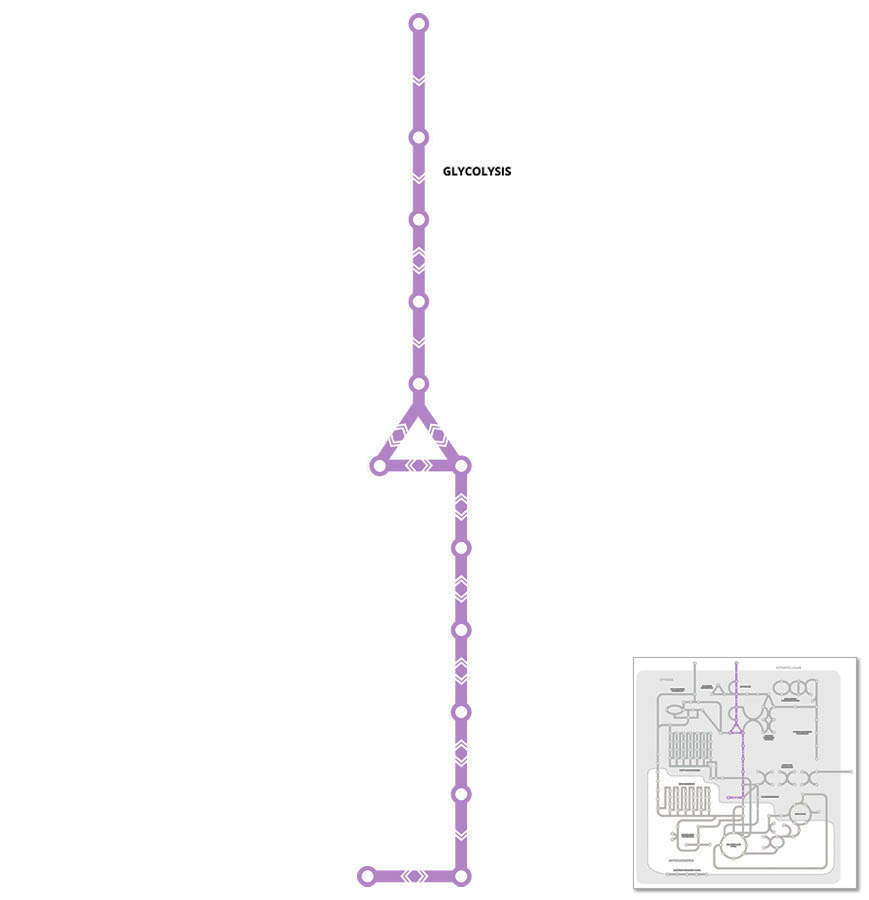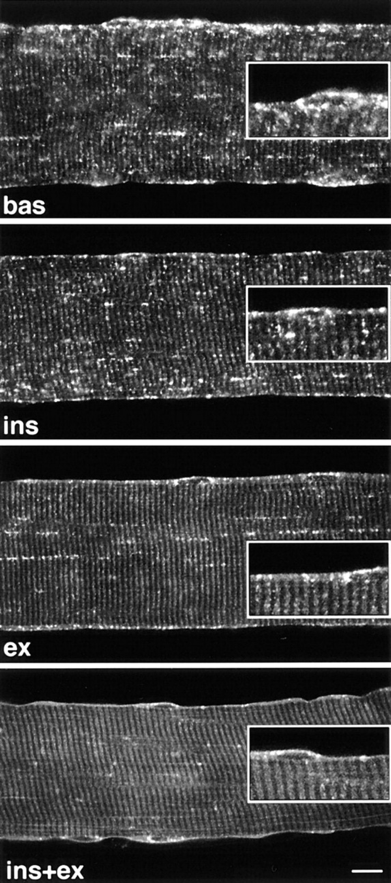
highlight all areas / label key areas

Glycolysis is the primary metabolic pathway for carbohydrate breakdown in all cells. This pathway produces energy in the form of adenosine triphosphate (ATP) from the conversion of Glucose or Glycogen (see Glycogen Metabolism pathway) into Pyruvate. It involves a series of enzymatically regulated steps (or reactions) that occur in the cytosol. The overall reaction is:
1 Glucose + 2 (ADP + Pi) + 2 NAD+ → 2 pyruvate + 2 ATP + 2 NADH
Regulation of glycolysis is complex, but in simple terms if the demand (utilisation) for ATP is high, then ATP production (synthesis) must increase. For this to occur, the rate of glycolysis must increase. Conversely, if ATP demand (or energy requirements of the cell) is low then the rate of glycolysis will be slowed.
The cell monitors its ATP requirements via a variety of different methods; so, regulation of glycolysis also occurs through different mechanisms. The major regulatory mechanism is allosteric modulation of the three essentially irreversible regulatory enzymes: Hexokinase, Phosphofructokinase and Pyruvate kinase.
Key points:
Glucose (C6H12O6) is a simple sugar (from the breakdown of more complex carbohydrates) that is a primary energy source for all cells/tissues in the body.
The concentration of glucose circulating in the blood is tightly controlled by processes that regulate glucose uptake into cells, the release of exogenous glucose into the circulation from the digestive system following the consumption of food or drink and by endogenous glucose production primarily by the liver.
Glucose-6-phosphate is an important intermediate metabolite of Glycolysis.
If the cell needs energy then Glucose 6-phosphate enters the glycolytic pathway (see Glycolysis pathway), otherwise a number of other pathways including glycogen metabolism (see Glycogen Metabolism pathway) and the pentose phosphate pathway (see Pentose Phosphate pathway) use this metabolic intermediate.
The final product of Glycolysis, Pyruvate can be transported into the mitochondria for oxidation (see The Citric Acid Cycle pathway) or converted to Lactate (in the cytosol).
The traditional view has been that Lactate production is the consequence of oxygen deficiency (or a final product of anaerobic metabolism), although there continues to be much debate on this issue. In simple terms, lactate production occurs whenever there is an imbalance between the rate of Pyruvate production from Glycolysis and Pyruvate use within the mitochondria.
Insufficient oxygen delivery to contracting skeletal muscle either during exercise or under conditions of hypoxia (such as anaemia or carbon dioxide poisoning) is associated with higher rates of muscle and blood Lactate production. However, other factors that influence Lactate production include elevated plasma adrenaline levels and muscle glycogen utilisation, via their effects on the rate of Pyruvate formation.
Lactate has been linked to muscle fatigue, although current research indicates that this is not the case. Rather at the whole body level, lactate is a significant metabolic intermediate that plays an important role in cell signalling, and is a major precursor for Gluconeogenesis (see Gluconeogenesis pathway) in the liver.
The regulation of glucose into cells occurs via facilitated diffusion mediated by a family of glucose transporters (GLUT). GLUT2 is the isoform responsible for glucose uptake into the liver. GLUT4 is the isoform responsible for insulin and contraction stimulated glucose transport, and is found primarily in adipose tissue and in skeletal and cardiac muscle.
In response to elevated insulin levels, GLUT4 translocates from a storage site inside cells, to the cell surface (or plasma membrane) where it facilitates the diffusion or uptake of glucose from the blood into the cell.
Muscle contraction or exercise can also induce GLUT4 translocation to the muscle cell membrane to increase glucose uptake. The underlying cellular processes where muscle contraction stimulates GLUT4 translocation is different from insulin. This ensures that the glucose required to meet the energy demand of contracting muscle is maintained, despite the fact that circulating insulin levels decline during exercise.

Once within cells (cytosol), Glucose is rapidly phosphorylated (a phosphate group is added) by the enzyme Hexokinase (also known as Glucokinase in the liver) to form Glucose-6-phosphate (G6P).
Glucose + ATP → Glucose-6-phosphate + ADP
This reaction ensures that Glucose-6-phosphate is trapped in the cell (cytosol), and maintains the concentration gradient to allow glucose to continue to enter the cell.
Key points:
Inhibited by:
Phosphofructokinase is a rate-limiting enzyme that regulates this committed step in Glycolysis:
Fructose-6-phosphate + ATP → Fructose 1, 6-bisphosphate + ADP
Key points:
Activated by:
Inhibited by:
This enzyme regulates a reversible reaction which breaks down Glyceraldehyde 3-phosphate (G3P); a three-carbon phosphate molecule produced in the first phase of Glycolysis.
Glyceraldehyde 3-phosphate + NAD+ + Pi ↔ 1,3-Bisphosphoglycerate + NADH + H+
Key points:
This enzyme regulates the first of the two reactions of Glycolysis that generate of ATP:
1,3-Bisphosphoglycerate + ADP ↔ 3-Phosphoglycerate + ATP
Key points:
This enzyme controls the irreversible final step of Glycolysis, and is the second of two reactions in Glycolysis that generate ATP:
Phosphoenolpyruvate + ADP → Pyruvate + ATP
Key points:
Activated by:
Inhibited by:
Lactate dehydrogenase (LDH) is a reversible enzyme that controls the production of lactate and regenerates cytosolic NAD+ from NADH that is crucial for maintaining the rate of glycolysis:
Pyruvate + NADH + H+ ↔ Lactate + NAD+
As this is a reversible reaction, the amount of substrate determines which direction the reaction will proceed (mass-action effect), but there are also several isoforms of this enzyme with different affinities for either Lactate or Pyruvate.